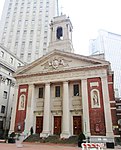Manhattan Community Board 1

The Manhattan Community Board 1 is a New York City community board encompassing the neighborhoods of Battery Park City, the Financial District, the South Street Seaport, and TriBeCa in Lower Manhattan in the borough of Manhattan as well as Liberty Island, Ellis Island and Governors Island. It is bounded by Baxter Street, Pearl Street, the Brooklyn Bridge and the East River on the east, Upper New York Bay on the south, the Hudson River on the west and Canal Street on the north. Manhattan Community Board 1's current Chairperson is Anthony Notaro, Jr. and its staff includes: District Manager Lucian Reynolds, Director of Land Use and Planning Diana Switaj, Planning Consultant Michael Levine, Community Liaison Tamar Hovsepian and Community Coordinator Lucy Acevedo.The Manhattan Community Board 1 office is located at 1 Centre Street, Room 2202 North, New York, NY 10007.
Excerpt from the Wikipedia article Manhattan Community Board 1 (License: CC BY-SA 3.0, Authors, Images).Manhattan Community Board 1
Centre Street, New York Manhattan
Geographical coordinates (GPS) Address Website Nearby Places Show on map
Geographical coordinates (GPS)
| Latitude | Longitude |
|---|---|
| N 40.7129 ° | E -74.0037 ° |
Address
David N. Dinkins Manhattan Municipal Building
Centre Street 1
10007 New York, Manhattan
New York, United States
Open on Google Maps











